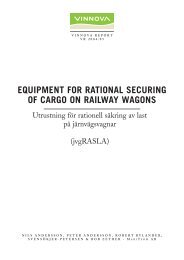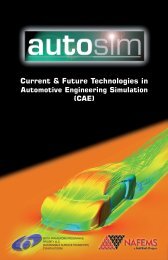WP3: Rail Passenger Transport - TOSCA Project
WP3: Rail Passenger Transport - TOSCA Project
WP3: Rail Passenger Transport - TOSCA Project
You also want an ePaper? Increase the reach of your titles
YUMPU automatically turns print PDFs into web optimized ePapers that Google loves.
PD. Space-efficient train<br />
According to (RSSB, 2007) and author’s estimations European long-distance high-speed trains<br />
have an average of about 2.2 seats per metre of train length, while most Japanese high-speed<br />
long-distance trains (Shinkansen) have an average of 3.3. About half of this effect is due to the<br />
use of wide carbodies in Japan but also due to less space for catering facilities and a more<br />
space-efficient interior layout in general. In Europe double-decker trains are used to a certain<br />
extent to improve space utilization, while wide-bodied trains (exterior width > 3.2 m) are only<br />
possible on a small number of rail networks, because of space restrictions by the rail<br />
infrastructure. Double-decker trains currently accommodate 2.5–2.7 seats per metre of train in<br />
the high-speed versions; sometimes more on regional trains. With a consequent use of spaceefficient<br />
train interiors - including intelligent seat design - some 10–15 % of energy and GHG<br />
emissions (per seat-km) could be saved (Kottenhoff et al, 2009) compared with reference<br />
trains. Note however, that the reference high-speed train in Table 2-1 is a double-decker which<br />
already has a comparatively high amount of seats per unit length of train. In local ‘City trains’,<br />
and many regional trains, there is already a high degree of space utilization, including<br />
sometimes also standing passengers, so in these cases no further improvement is anticipated.<br />
A particular mean of improved space utilization is the exchange of locomotive-hauled trains<br />
for so-called multiple unit trains (EMU=Electrical, DMU=diesel), having their propulsion<br />
equipment installed in the passenger cars. Usually train performance can also be enhanced<br />
(acceleration, speed, regenerative braking, etc) and the train mass per seat can be reduced.<br />
PE. Modular short train<br />
Today many trains have a length of 5–16 cars (or equivalent if shorter carbodies than normal)<br />
due to the required capacity during peak hours. A large proportion of these trains is running in<br />
the same formation all the time, without shortening the train length during off-peak hours. This<br />
is due either to the fixed long train configuration, which does not allow any decoupling (in selfpropelled<br />
multiple units), or to the cost and time needed for decoupling cars in a loco-hauled<br />
train. If trains are made in shorter self-propelled modules (3–6 cars) these modules can quite<br />
easily be de-coupled, and the train length is halved when the full size is not needed. A halfsize-train<br />
would save some 40 % of energy compared with a full-size one. To some extent<br />
these principles are already applied in today’s operations, but they could be extended to further<br />
areas. With an assumed 20 % (more than today) of the trains running at half-size some 6–8 %<br />
of energy should be saved. However, it is at this stage uncertain to what extent these principles<br />
can be effectively used within Europe. In some EU member states safety regulations presently<br />
require some 5–10 m of empty (i.e. no passenger) space at each end of the train, which would<br />
neutralize the benefits of shorter trains.<br />
PF. Eco-driving - driving advice or automatic operation<br />
Optimization of driving style means, for example, coasting before braking and downhill<br />
approach, use of regenerative brakes as the ordinary brake, running slowly when time allows,<br />
etc. Such optimization is estimated to have a saving potential in the order of 10–15 % in its<br />
first generation, compared with the average manual driving of 2009 which is the reference in<br />
Table 2-1 (<strong>Rail</strong>energy, 2009) (Lindemann, 2010) (Luijt, 2010).<br />
Driving can be optimized by training for skilled driving, by on-line computerized support and<br />
advice to drivers or by automatic train operation. The latter may be used on metros and<br />
dedicated commuter railways. To a small extent this technology is already commercially<br />
introduced, but is estimated to be improved and fully implemented in modern trains within the<br />
next 10 years. These improvements are relatively inexpensive to introduce and are applicable<br />
to most types of trains.<br />
Deliverable D4 – <strong>WP3</strong> passenger 9
















